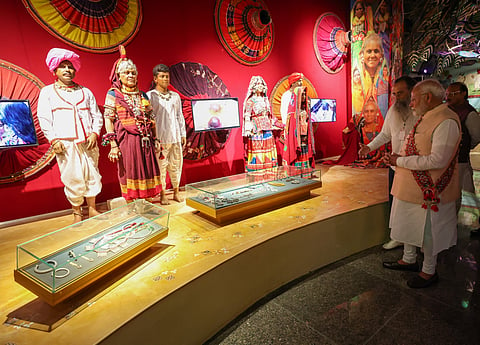
- Destinations
- Experiences
- Stay
- What's new
- Editor’s Picks
- Responsible Tourism
- CampaignsCampaigns
- Subscribe

On October 5, 2024, the prime minister of India, Narendra Modi, inaugurated a new museum in Poharadevi, a town in the Washim district of Maharashtra. The Banjara Virasat Museum is dedicated to the Banjara community—a group of nomadic tribes originally from Rajasthan who have now settled in Karnataka, Andhra Pradesh, Madhya Pradesh, Gujarat and Maharashtra.
Here’s what you can expect from a visit to the Banjara Virasat Museum.
The five-storey building will function as an important cultural hub for Maharashtra’s Banjara people. It is located in Poharadevi because it is considered a sacred site by the community—they often refer to it as the “Kashi of the Banjara community.” The museum adds to the spiritual and historical importance of the region, which is home to the tomb of Sant Sewalal Maharaj, a revered spiritual leader, and the shrine of saint Ramraobapu Maharaj. The prime minister paid tributes at the latter's samadhi during his visit.
The museum itself has 13 galleries that depict the legacy of the community through portraits of Banjara leaders, historical movements and artefacts that depict their way of life. The Banjaras were historically pastoralists, traders, breeders and transporters of goods in the inland regions of India. Although traditionally a migratory people, each year, they settled in fixed-village accommodations during the monsoon months of June to August. Despite the challenges of the 21st century, they have managed to retain their art and cultural traditions to the present day, including their music, dance, rangoli art, textile embroidery, tattooing, and painting forms.
The immersive space of the Banjara Virasat Museum is designed to take visitors on a journey through the history, traditions and cultural practices of the Banjaras. It offers a deep dive into their lifestyle, from their art and crafts to their religious practices, providing a unique insight into one of India’s distinct communities. Visitors to the museum can explore a wide range of exhibits, including traditional tools and everyday items, colourful clothing and intricate jewellery, as well as displays of the festivals, music and dance forms of the Banjara people. The museum also showcases their traditional crafts, like embroidery and beadwork, along with interactive exhibits such as virtual reality experiences.
The museum is part of a broader development initiative led by the state minister of soil and water conservation, Sanjay Rathod. The project aims to preserve and promote Banjara heritage while also boosting tourism in the region. This comprehensive development plan is expected to transform Poharadevi into a major cultural and religious destination, too.
(With inputs from multiple news reports)
